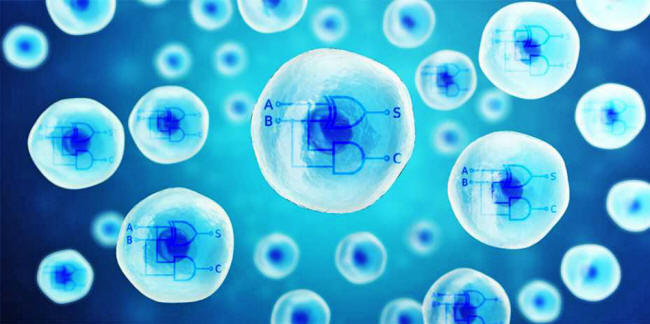|
by Peter Rüegg
ETH researchers introduced two cores made of biological materials into human cells. (Graphic: Colourbox/Steven Emmett, ETH Zurich)
two CRISPR-Cas9-based core processors into human cells. This represents a huge step towards creating powerful biocomputers...
Controlling gene expression through gene switches based on a model borrowed from the digital world has long been one of the primary objectives of synthetic biology.
The digital technique
uses what are known as logic gates to process input signals,
creating circuits where, for example, output signal C is produced
only when input signals A and B are simultaneously present.
However, these had some serious disadvantages:
More complex
computational processes in cells are thus possible only under
certain conditions, are unreliable, and frequently fail.
Cells are slower in comparison, but can process up to 100,000 different metabolic molecules per second as inputs.
And yet previous cell computers did not even come close to exhausting the enormous metabolic computational capacity of a human cell.
The processor developed
by the ETH scientists is based on a modified
CRISPR-Cas9
system and basically can work with as many inputs as desired in the
form of RNA molecules (known as guide RNA).
In response to input delivered by guide RNA sequences, the CPU regulates the expression of a particular gene, which in turn makes a particular protein.
With this approach, researchers can program scalable circuits in human cells - like digital half adders, these consist of two inputs and two outputs and can add two single-digit binary numbers.
To do so, they used CRISPR-Cas9 components from two different bacteria.
Fussenegger was delighted with the result, saying:
This biological computer is not only extremely small, but in theory can be scaled up to any conceivable size.
With a properly programmed CPU, the cells could interpret two different biomarkers as input signals.
Such a system could find application in medicine, for example in cancer treatment.
For example, if biomarker B remains in the body for a longer period of time at a certain concentration, this could indicate that the cancer is metastasising.
The biocomputer would then produce a chemical substance that targets those growths for treatment.
He continues:
These cells continually receive information from the outside world or from other cells, process the signals and respond accordingly - whether it be by emitting chemical messengers or triggering metabolic processes.
His next goal is to integrate a multicore computer structure into a cell.
|


